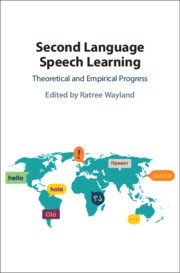Book contents
- Second Language Speech Learning
- Second Language Speech Learning
- Copyright page
- Dedication
- Contents
- Figures
- Tables
- Contributors
- Preface
- Acknowledgments
- Part I Theoretical Progress
- Part II Segmental Acquisition
- Part III Acquiring Suprasegmental Features
- Part IV Accentedness and Acoustic Features
- Part V Cognitive and Psychological Variables
- Chapter 16 Self-Reported Effort of Listening to Nonnative Accented English Depends on Talker Pausing and Listener Working Memory Capacity
- Chapter 17 Investigating the Role of Cognitive Abilities in Phonetic Learning of Foreign Consonants and Lexical Tones
- Chapter 18 Auditory Priming Effects on the Pronunciation of Second Language Speech Sounds
- Chapter 19 Indexical Effects in Cross-Language Speech Perception
- Chapter 20 The Role of Orienting Attention during Perceptual Training in Learning Nonnative Tones and Consonants
- Index
- References
Chapter 20 - The Role of Orienting Attention during Perceptual Training in Learning Nonnative Tones and Consonants
from Part V - Cognitive and Psychological Variables
Published online by Cambridge University Press: 21 January 2021
- Second Language Speech Learning
- Second Language Speech Learning
- Copyright page
- Dedication
- Contents
- Figures
- Tables
- Contributors
- Preface
- Acknowledgments
- Part I Theoretical Progress
- Part II Segmental Acquisition
- Part III Acquiring Suprasegmental Features
- Part IV Accentedness and Acoustic Features
- Part V Cognitive and Psychological Variables
- Chapter 16 Self-Reported Effort of Listening to Nonnative Accented English Depends on Talker Pausing and Listener Working Memory Capacity
- Chapter 17 Investigating the Role of Cognitive Abilities in Phonetic Learning of Foreign Consonants and Lexical Tones
- Chapter 18 Auditory Priming Effects on the Pronunciation of Second Language Speech Sounds
- Chapter 19 Indexical Effects in Cross-Language Speech Perception
- Chapter 20 The Role of Orienting Attention during Perceptual Training in Learning Nonnative Tones and Consonants
- Index
- References
Summary
Previous studies have shown that directing learners’ attention during perceptual training facilitates detection and learning of unfamiliar consonant categories (Guion & Pederson, 2007; Pederson & Guion, 2010). The current study asks whether this attentional directing can also facilitate other types of phonetic learning. Monolingual Mandarin speakers were divided into two groups directed to learn either 1) the consonants or 2) the tones in an identification training task with the same set of Southern Min monosyllabic words containing the consonants /pʰ, p, b, kh, k, ɡ, tɕʰ, tɕ, ɕ/ and the tones (55, 33, 22, 24, 41). All subjects were also tested with an AXB discrimination task (with a distinct set of Southern Min words) before and after the training. Unsurprisingly, both groups improved accuracy in the sound type to which they attended. However, the consonant-attending group did not improve in discriminating tones after training and neither did the tone-attending group in discriminating consonants -- despite both groups having equal exposure to the same training stimuli. When combined with previous results for consonant and vowel training, these results suggest that explicitly directing learners’ attention has a broadly facilitative effect on phonetic learning including of tonal contrasts.
Information
- Type
- Chapter
- Information
- Second Language Speech LearningTheoretical and Empirical Progress, pp. 485 - 502Publisher: Cambridge University PressPrint publication year: 2021
References
Accessibility standard: Unknown
Why this information is here
This section outlines the accessibility features of this content - including support for screen readers, full keyboard navigation and high-contrast display options. This may not be relevant for you.Accessibility Information
- 1
- Cited by
